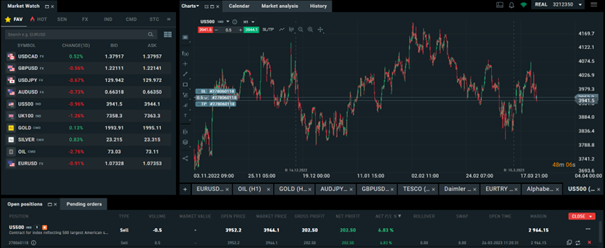The article on Reuters said that concerns about the stability of the banking system led to a drop in global stocks, while government bonds were in demand as a safe-haven investment. Not very bright news for the markets I thought to myself. These events have heightened worries about the resilience of the banking sector, which have been exacerbated by recent turmoil in the U.S. and European banking sectors. U.S. Treasury Secretary Janet Yellen has attempted to alleviate investor concerns about the health of U.S. lenders and the potential impact of a lending crisis on smaller banks, which play a significant role in supporting sectors such as commercial real estate.
If the news regarding markets are not positive, then this can mean only one thing – the charts can be expected to be in red. [1] I opened the S&P 500 chart and it proved my concerns. Despite not being that big of correction, there was a drop. And since it’s only a beginning, it’s just a question or matter of time, when I can expect further volatility. [2] In the last two days, index fell for about 4%. Right before the drop I can see a quick growth, which stopped at the price of 4073,7 USD. Right now, the price of an index is 3946,5 which means that the price fell for more than 120 USD. In most scenarios, this would give me a good entry point for long position, however the situation on the market, I have decided to go short this time. But, I will keep an eye on it and accordingly sell and open a long position. Just to be sure, I checked the indicators on Investing, which again confirmed my suspicion.

Link to a 5 year chart: https://www.investing.com/indices/us-spx-500
*Past performance is no guarantee of future results.
[1,2] Forward-looking statements are based on assumptions and current expectations, which may be inaccurate, or based on the current economic environment which is subject to change. Such statements are not guaranteeing of future performance. They involve risks and other uncertainties which are difficult to predict. Results could differ materially from those expressed or implied in any forward-looking statements.








